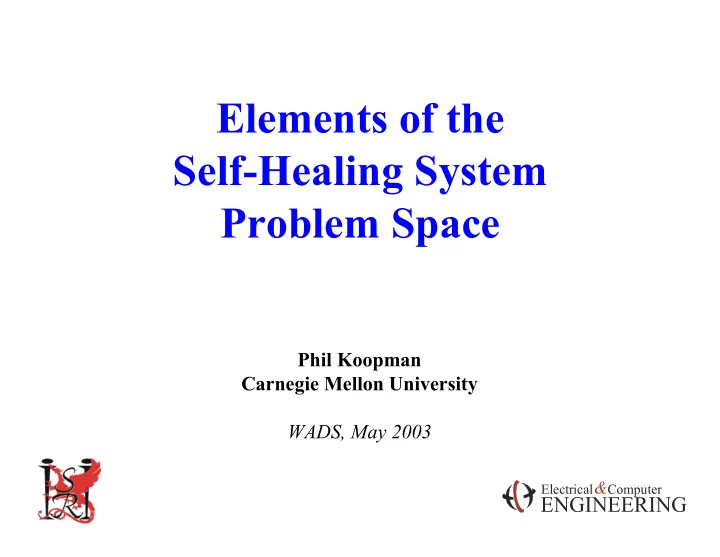

Elements of the Self-Healing System Problem Space Phil Koopman Carnegie Mellon University WADS, May 2003 & Electrical Computer ENGINEERING
Overview “Self-Healing” – it’s getting attention, but what does it mean? ◆ • This talk is based on observations from the most recent Workshop on Self- Healing Systems (WOSS’02) Description of some general problem elements of Self Healing research ◆ • Fault models – what is an “injury”? • System responses – what is “healing”? • System incompleteness – what’s unknown? • Design context – what injuries are beyond healing? Two challenges: ◆ 1. Fault Tolerant Computing : broaden perspectives with SH ideas 2. Self Healing : don’t waste time reinventing existing FT ideas 2
Fault Model – “injury” ◆ First question in fault tolerant computing is: “What is the fault model?” ◆ Reasons for a fault model • Need to know expected faults to measure fault tolerance coverage • Not all faults are equal in time, space, severity ◆ Some challenges: • Is Injury == Fault ???? • Is a software defect an injury? 3
Self-Healing Fault Model Issues ◆ Fault duration: • Permanent / intermittent / transient ◆ Fault manifestation: • Fail silent / Byzantine / correlated faults • Impaired: run-time, reserve capacity, brittleness, resource consumption ◆ Fault source: • Wear-out / design defects / reqts. defects / environment change / malicious ◆ Granularity: • One designer’s “system” is the next level designer’s “component” • Transistor failure / … node failure … / system failure ◆ Fault profile expectations: • No faults / historically known faults / foreseen faults / unforeseen faults • Random+independent / random+correlated / expected / predicted 4
System Response – “healing” ◆ After an injury, what happens? ◆ Fault tolerant system responses include: • Diagnosis / identification • Isolation / containment • System reconfiguration • System reinitialization ◆ Does “healing” mean something additional? • Or is it a difference at a different level? 5
Self Healing System Responses Fault Detection: ◆ • Self-test / pairwise checking / peer checking / supervisor checking • Self-injected faults to ensure detection is working? Degradation during & after healing: ◆ • Fail-operational / degraded performance / fail-fast+ fail-safe Response: ◆ • Fault masking / failover / reconfiguration • Optimize for: safety / reliability / availability / … • Preventative (periodic reboot) / Proactive (diagnosis-based) / Reactive Recovery of state: ◆ • Hot swap / restore quiescent state / warm boot / cold boot • Rollback / recovery block / control gain changes / rollforward / run-while-reconfiguring • What about recovering component state? Time constants: ◆ • Most faults are transient • Important that system response time constant be faster than injury arrival rate System Assurance: ◆ • After injury / during healing / after healing 6
System Completeness – What do we know and when? ◆ System self-knowledge • How much self-knowledge is required for healing? • How should healing knowledge be abstracted? • How do we deal with not knowing how much the system doesn’t know? ◆ Designer knowledge • Not all systems are complete when design is “done” • Even if complete, we won’t know everything about all components • How do we deal with not knowing how much we don’t know? 7
Self Healing System Completeness ◆ Architectural Completeness: • Proprietary & known / open & regulated / extensible ◆ Designer Knowledge: • Component knowledge (especially COTS components) • Faulty behavior characterizations • How do you heal after suffering a component behavior that is “unspecified”? ◆ System Self-Knowledge: • How complete is system’s self-model? (idea of reflection) • Is healing an intentional or emergent behavior? ◆ System Evolution • Configuration changes & usage changes • Are outages random / predictable / schedulable? 8
Design Context – What are the scope limits? ◆ The real world is a messy place – what assumptions are made? • Homogeneous system? • “Perfect” components (e.g., perfect healing management software?) • … ◆ What is the size of the system? • A single software module? • A complex software system? • A person plus a computer system? • The North American power grid? • The Internet? • Does teaching users to press CTL-ALT-DEL achieve “self-healing” of the user+computer “system”? 9
Self Healing Design Context Abstraction Level: ◆ • Implementation / design / architecture / … Component Homogeneity: ◆ • Can any software component run in any node? • Perfect configuration homogeneity / plug-compatible / heterogeneous Predetermination of system behavior: ◆ • Specific design / rule-based system / service discovery / emergent behavior User Involvement in healing: ◆ • User direction / user-provided hints / user ability to tune / invisible to user System Linearity: ◆ • Linear+composable / monotonic / mildly discontinuous / arbitrary • Single operating mode / mode changes System scope: ◆ • Component / computer system / computer+person / enterprise / society 10 10
Conclusions “Self-Healing” potentially encompasses a lot of ground ◆ • Smaller than expected intersection of research assumptions at WOSS02 • Consensus will take a while Some of this has been done before! ◆ • Fault models – well known in FT, don’t reinvent without good reason • System responses – how different are they from FT? • System incompleteness – FT usually assumes relative completeness • Design context – plenty of room for novelty in both FT & SH • But there is plenty of room for more good research A final thought: ◆ 1. Fault Tolerant Computing : broaden perspectives with SH ideas 2. Self Healing : don’t waste time reinventing existing FT ideas even better: articulate the novelty of approaches 11 11
Recommend
More recommend